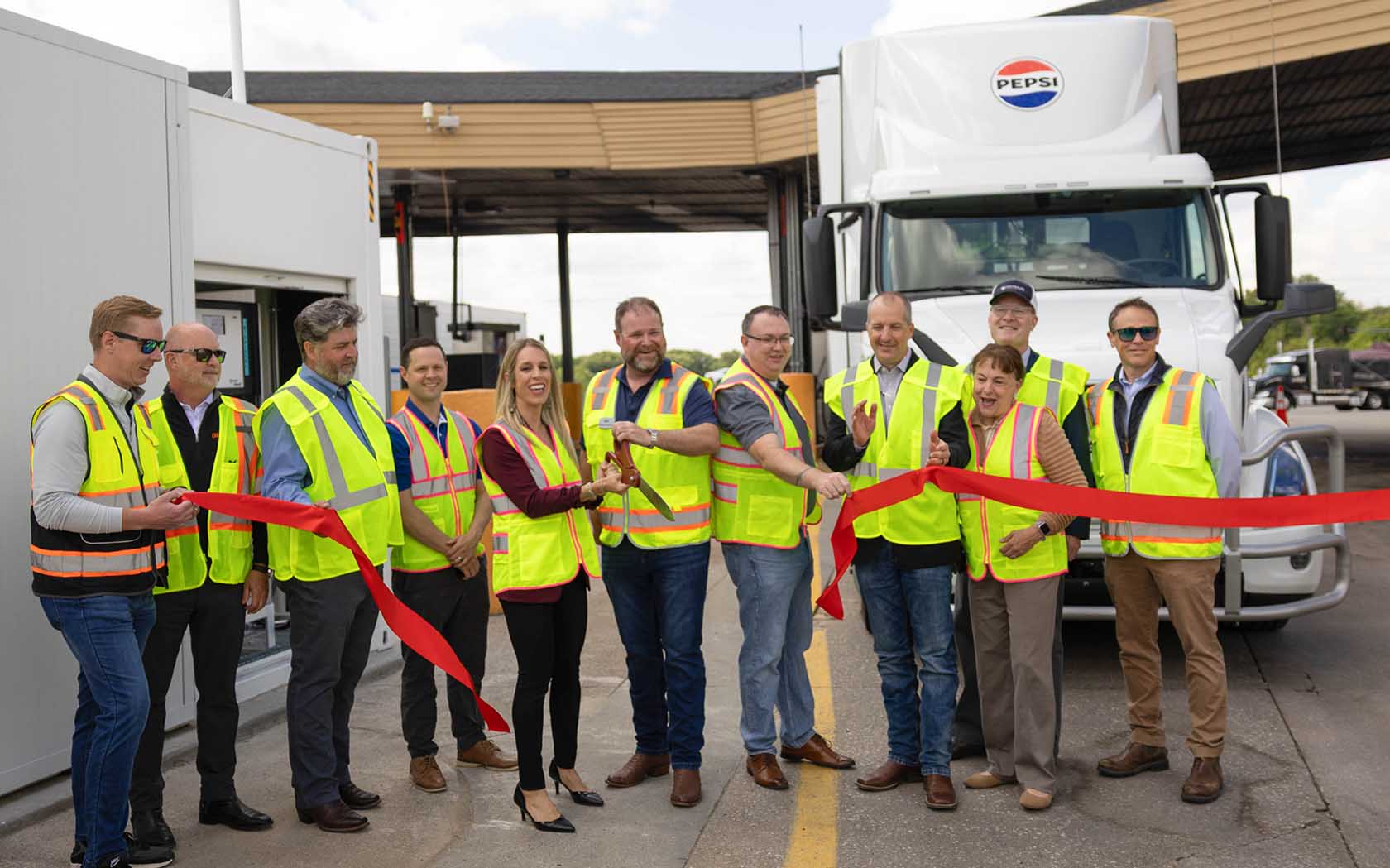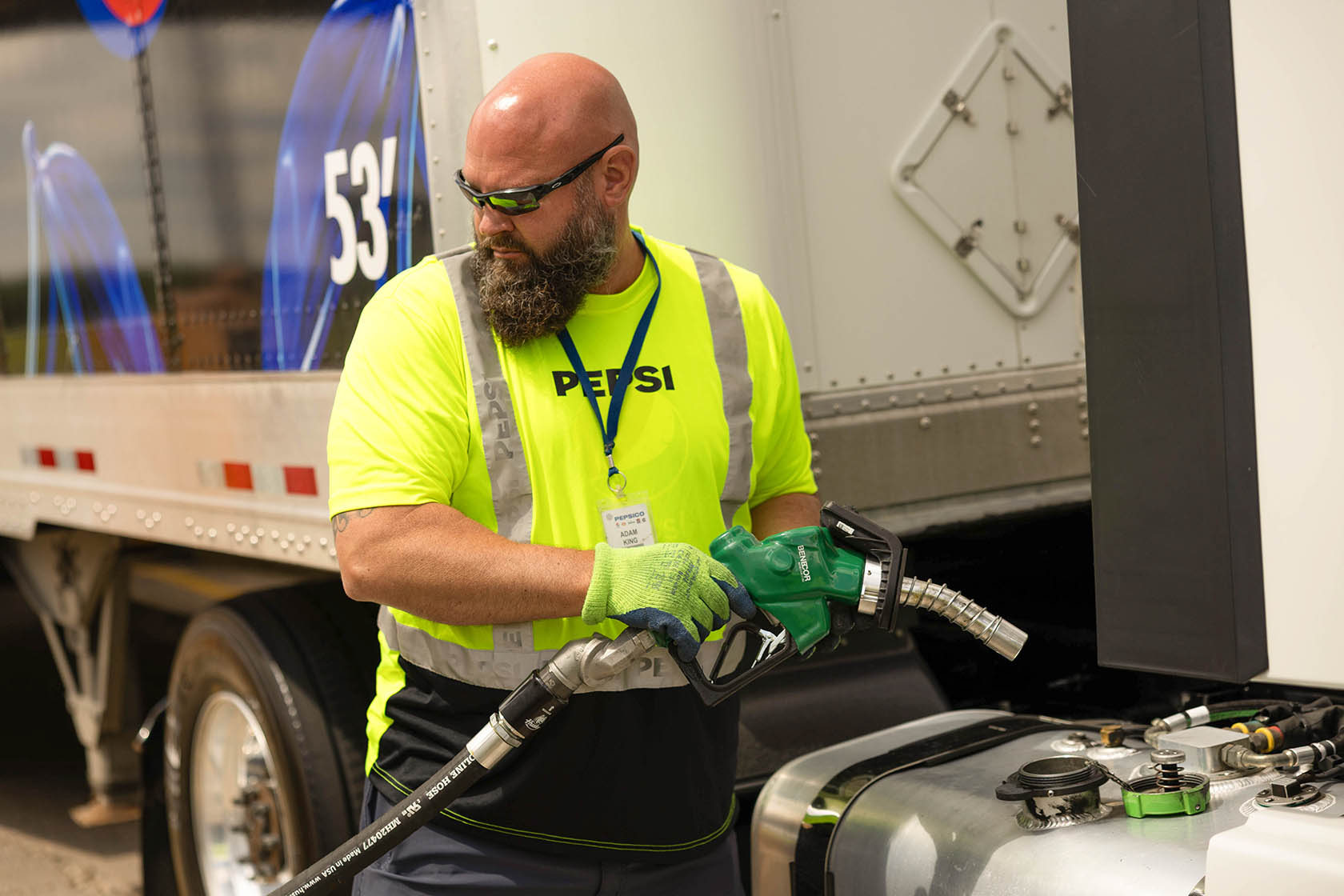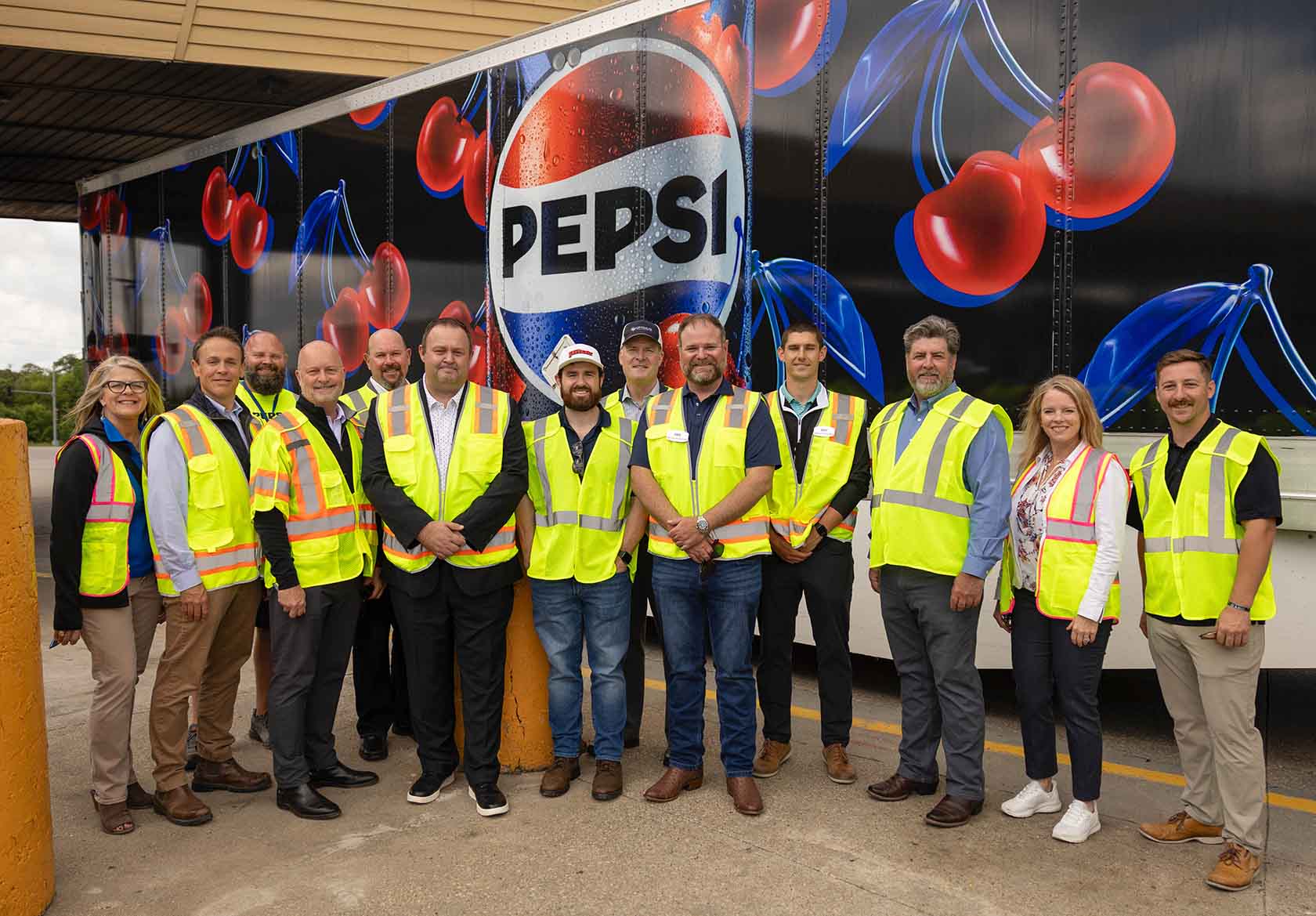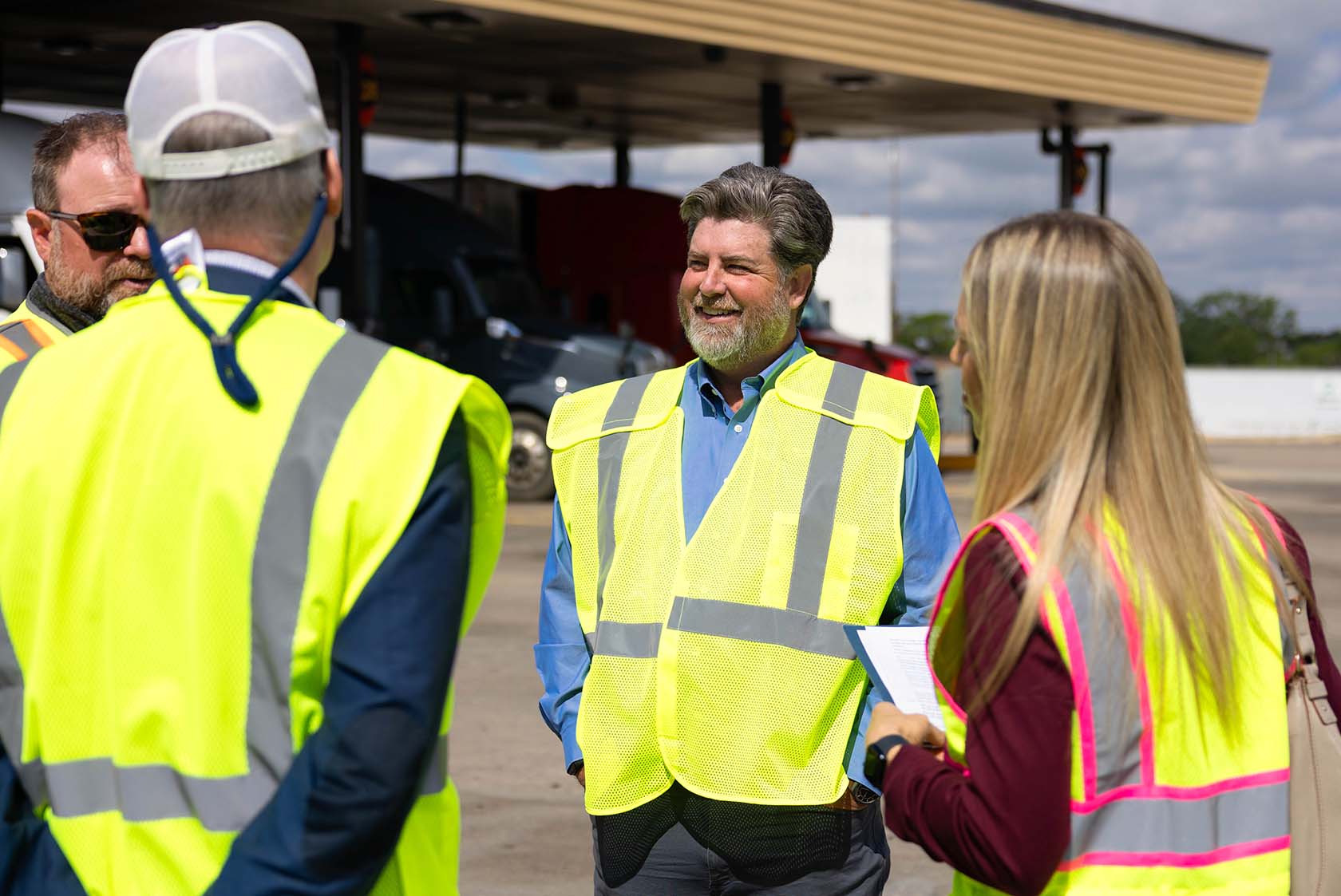
(Photo: Iowa Soybean Association / Joclyn Kuboushek)
Iowa’s first above-ground B99 fueling pump
June 5, 2025 | Bethany Baratta
When Adam King steered his semi with 53-foot trailer—emblazoned with Wild Cherry Pepsi advertising on its trailer façade—up to a fuel pump recently, he had a group of spectators. Gathered in the parking lot of the Pilot Travel Center, just off Douglas Avenue in Des Moines, onlookers gawked as King hopped out of his semi and began filling the tank with nearly 100% biodiesel. It wasn’t just another day in King’s life as a lead driver trainer for PepsiCo. But this wasn’t an ordinary day.
May 29 marked the first day that Iowa’s first above-ground B99 fueling pump was open for business.
“Coast to coast, north to south, we try our very best to put biodiesel, renewable diesel and ethanol into every molecule of fuel we sell at Pilot,” says Eric Fobes, head of renewables at Pilot Flying J.
The installation of the pump represents a core pillar for the company—shaping the future of energy.
“To me and our customers it’s important that we are offering decarbonized solutions,” Fobes says. “This is one of those offers.”

Situated just five minutes away from PepsiCo’s Urbandale plant, the location is ideal for drivers like King and others who aspire to use cleaner fuel options like B99, made from 99% biodiesel and 1% diesel.
“This station is a major win for sustainable energy, helping to make low carbon solutions more accessible,” says Sarah Towles, senior director of government affairs for PepsiCo.
PepsiCo’s semis are equipped with Optimus Technologies’ Vector System which enables heavy-duty diesel engines to operate on 100% biodiesel (B100), resulting in a substantial decrease in CO2 emissions by 85-95%, according to Karl Thomas, an account executive for Optimus Technologies, based in Pittsburgh. Since 2018, Optimus Technologies has equipped more than 1,200 new and existing trucks with the Vector System, allowing for greater use of lower carbon fuels, like biodiesel.
B99 on site
Benecor made the B99 delivery system possible through the Pilot Travel Center, situated between Douglas Avenue and Interstate 35. The Benecor station delivers a fully insulated and heated turnkey biodiesel storage and dispensing system for efficient, all-weather operation. The system, engineered in Michigan, enables on-site blending of biodiesel and diesel, offering a cost-effective way to meet high biofuel blend rates without needing additional underground infrastructure.
Benecor owner Brendan Foster says demand for the system his company manufactures demonstrates the demand for higher blends of biodiesel.
“We’re talking to other folks out there who are also asking how they can get the higher biofuel rates,” Foster says. “On-site blending means we’re able to provide a fairly inexpensive approach for the Pilots of the world to take advantage of available credits and offer now another outlet for biodiesel.”

Progress
The ribbon-cutting event marked progress in the biofuels space.
“This ribbon cutting isn’t just for a new pump—it’s a milestone worth celebrating for what it represents: real, on-the-ground progress in America’s transition to cleaner fuels,” says Dave Walton, a farmer and member of both Iowa Biodiesel Board and Iowa Soybean Association’s Board of Directors. The Iowa Soybean Association and Iowa Biodiesel Board contributed $25,000 in checkoff funding to this project.
The collaboration speaks to the partnerships that are helpful in increasing the demand for biodiesel, thereby increasing the demand for Iowa-grown soybeans.
“Biodiesel is critical to Iowa’s farm economy. It adds real value to every bushel of soybeans we grow—up to 13 percent – supporting local jobs, driving demand, and giving us an economic edge,” Walton says.
In 2024, Iowa’s then-10 operating biodiesel plants produced an estimated 350 million gallons, making it the top biodiesel-producing state. A study by Decision Innovation Solutions shows contributions to all sectors of the state's economy, including:
$123 million in labor income in Iowa, $520 million in value added and $2.2 billion in output (total sales).
Blends of 20% biodiesel (B20) and higher more than doubled in Iowa’s on-road diesel sales last year, growing to 35% in 2024, according to Walton.
Even so, 2025 hasn’t been easy for the biodiesel industry, Walton lamented.
“Some plants in Iowa are sitting idle. And like the broader ag sector, biodiesel producers have been feeling the strain of outside pressures,” he says.

Building demand
What could spur biodiesel production in the state?
“At the federal level, we’re continuing to encourage EPA to support a strong Renewable Fuel Standard. We’re asking for a volume of 5.25 billion gallons for 2026 – in line with our domestic capabilities,” says Walton, who has been using biodiesel on his farm for 20 years. “We also need workable tax incentive guidance on the federal level. That gives this industry the certainty and stability it needs to grow. The right policies—just like the right technologies and partnerships—can keep us moving forward.”
Certainty is key, says Iowa Secretary of Agriculture Mike Naig.
“You got to have certainty when it comes to this industry,” says Naig. “What we need—what we’re asking for—is a very strong renewable volume obligation (RVO) number that is set by EPA. Those are the type of things—as a condition by the renewable fuel standard, we would have a growing biofuels sector in this country.”
Iowa was the first state in the nation to implement a B30 initiative, reflects a “bold step in progress toward giving consumers more access to these products,” Naig says.
Commitments like those from PepsiCo and others who are using B99 to decarbonize their fleets drives demand. Tax policy and a strong RVO drive production.
“There’s a lot of talk about energy dominance by the president,” Naig says. “And I think, my goodness, what a great way to secure and build for energy independence and energy dominance than to really unleash homegrown, domestic renewable energy-biodiesel, ethanol, renewable diesel, and sustainable aviation fuel being key components. But you must send the right signals to the marketplace—an RVO would do that, and a tax policy in terms of incentivizing production. That could happen in the state and federal levels.”
Written by Bethany Baratta.
Back